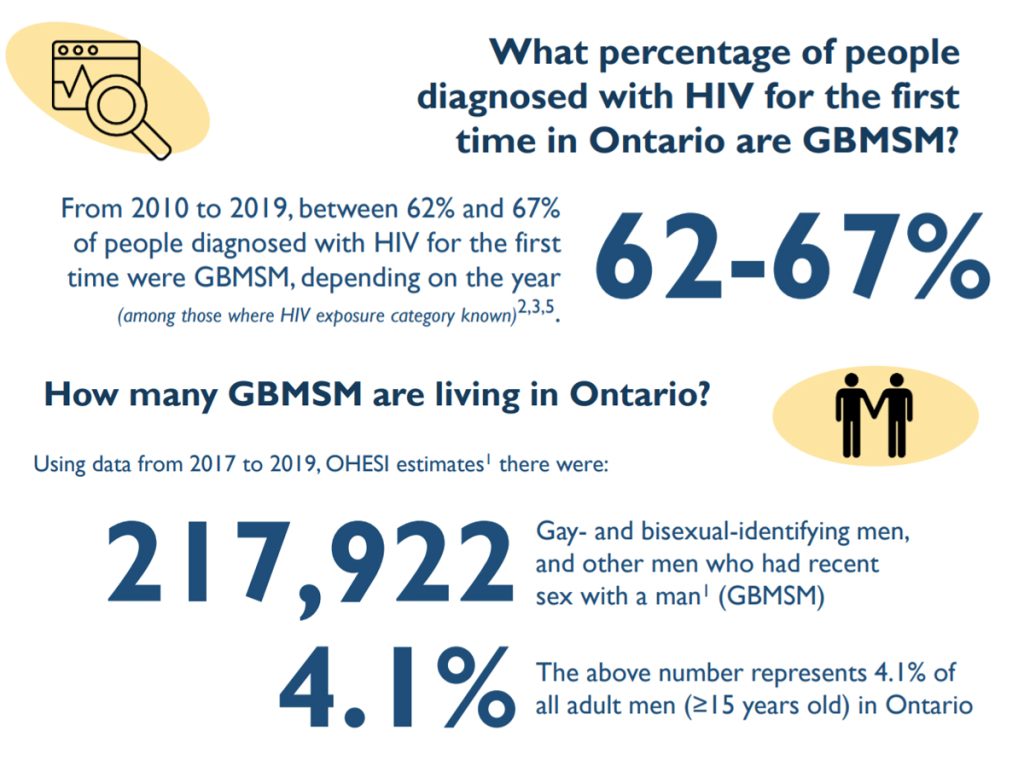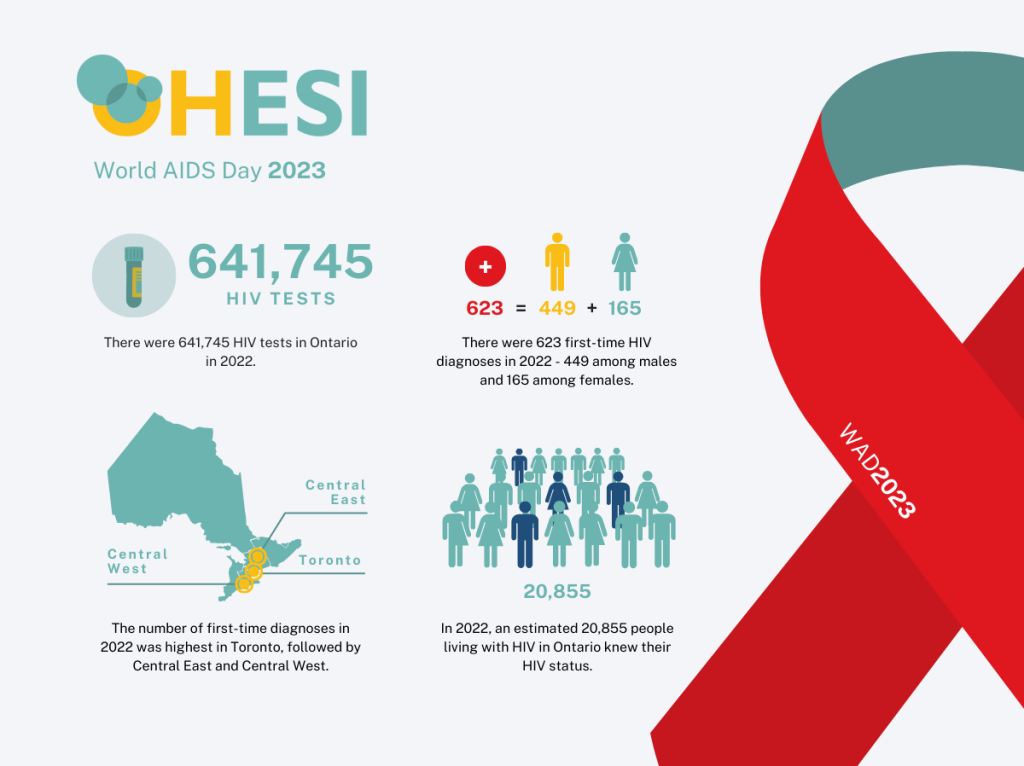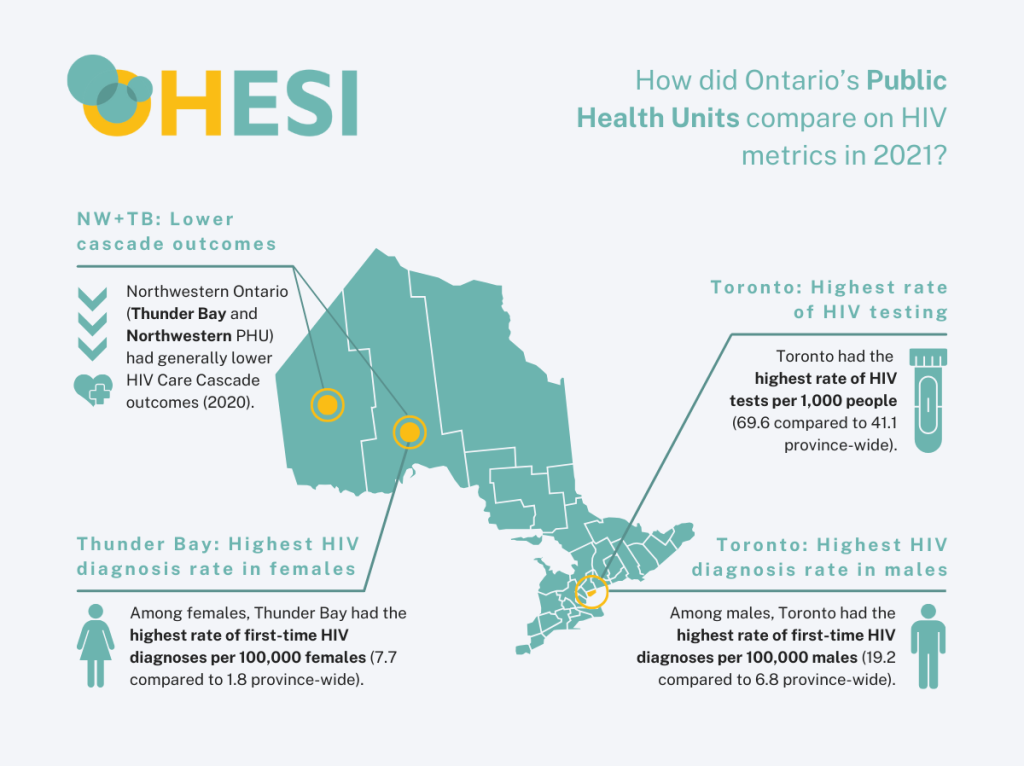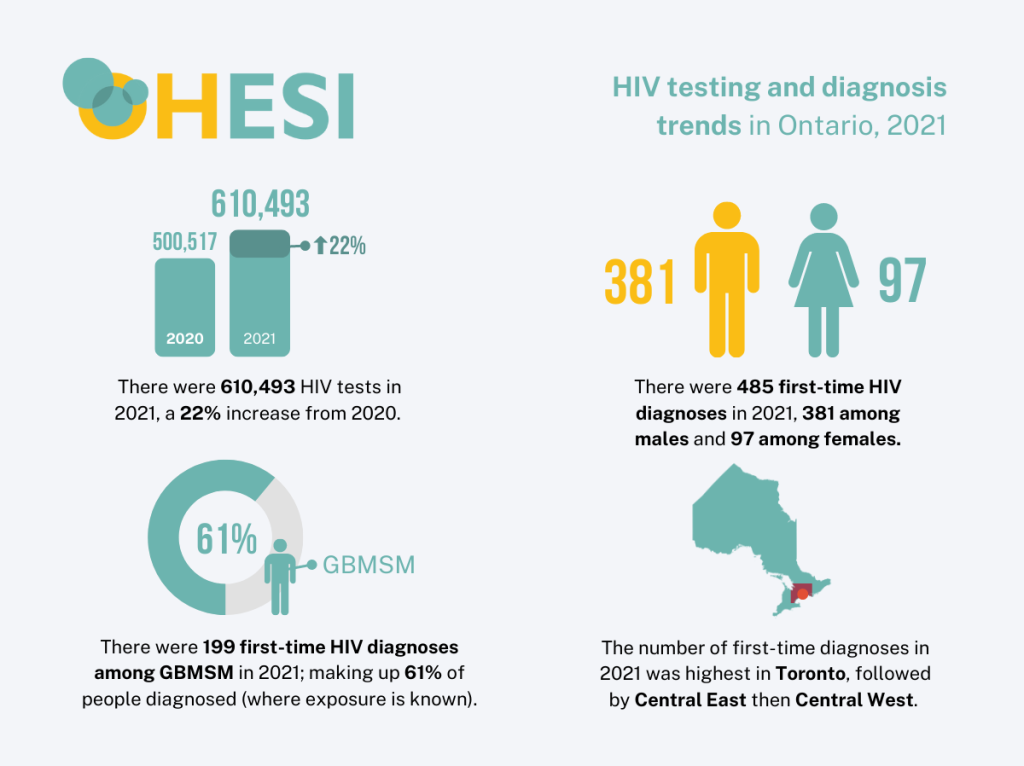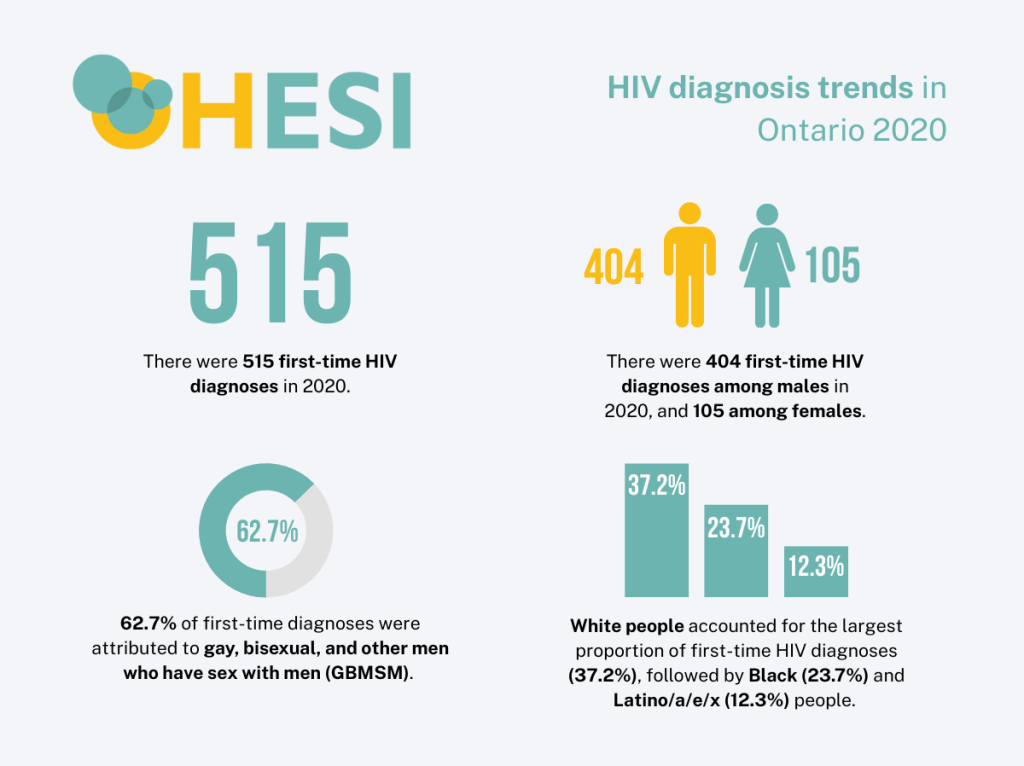Jun 30th, 2021
HIV epidemiology update for GBMSM in Ontario, 2019: factsheet and methods
Introduction
OHESI estimated the number of gay- or bisexual-identifying, and other men who have sex with men (GBMSM) living in Ontario for the time period of 2017-2019. This estimate is provided in the OHESI factsheet “HIV epidemiology update for gay, bisexual, and other men who have sex with men (GBMSM) in Ontario, 2019” (French version here). The estimate was then used to produce an estimated prevalence of diagnosed HIV specifically within GBMSM. Here, OHESI outlines the methods developed to produce the estimated number of GBMSM in Ontario and prevalence of diagnosed HIV among them.
GBMSM working group
The methods were developed in consultation with a working group of experts in GBMSM health. This working group included:
- Barry Adam; University of Windsor
- David Brennan; University of Toronto
- Todd Coleman, Wilfred Laurier University
- Sean Colyer; Ontario HIV Treatment Network
- Ken English; AIDS and Hepatitis C Programs, Ministry of Health
- Dane Griffiths; Gay Men’s Sexual Health Alliance
- Maya Kesler; Ontario HIV Treatment Network
- Abigail Kroch; Ontario HIV Treatment Network
- Nathan Lachowsky; University of Victoria, Community-Based Research Centre
Definition of GBMSM population
For the purposes of OHESI’s estimate, GBMSM included all gay-identifying men, all bisexual-identifying men, and any other men who reported anal sex with another man in the past 6 or12 months. The two recall periods (6 or 12 months) exist because the estimates were produced through averaging estimates produced using two data sources for points of adjustment (see below), each with a different recall period.
Data sources and indicators used
Canadian Community Health Survey (CCHS), Statistics Canada
- Data collected using computer assisted personal and telephone interview software
- Data across 2017 to 2019 annual surveys used to produce a single estimate across the three-year period
- Each participant weighted to account for participation bias in the survey1
- Participants aged 15 years or older
- Questionnaire items used:
- 2017, 2018: Do you consider yourself to be…?
- Heterosexual (sexual relations with people of the opposite sex)
- Homosexual, that is lesbian or gay (sexual relations with people of your own sex)
- Bisexual (sexual relations with people of both sexes)
- 2019: What is your sexual orientation….?
- Heterosexual
- Homosexual
- Bisexual
- Please specify
- CCHS redistributed “please specify” to the first three response options where appropriate
- Have you ever had sex? Please include vaginal and anal sex.
- Yes / No / Refused / Don’t Know
- (If ever had sex) In the past 12 months, have you had sex with a male?
- Yes / No / Refused / Don’t Know (Yes considered sexually active)
- More information about the CCHS can be found here.
- 2017, 2018: Do you consider yourself to be…?
Sex Now 2019 Survey, Community Based Research Centre (CBRC)
- Online survey of gay, bisexual, transgender, Two-Spirit, and queer (GBT2Q) men’s health
- Data collection Fall 2019, Canada-wide, Ontario-specific data used here
- Inclusion criteria:
- Cis or trans man aged 15 years or older living in Canada
- non-straight sexual identity or straight and reported sex with another man in past five years
- Questionnaire items used:
- Would you reveal your sexual orientation if asked in a Statistics Canada survey?
- Very likely
- Likely
- Somewhat unlikely
- Totally unlikely
- Likely items collapsed to give proportion likely to disclose
- In the PAST 6 MONTHS how many men have you had sex with?
- Numeric response
- (If had any sex with man in past 6 months) How many did you have anal sex with?
- Numeric response (>0 considered sexually active)
- More information about the Sex now survey can be found here, and about past surveys (including 2019) and their data here.
- Would you reveal your sexual orientation if asked in a Statistics Canada survey?
Modeling methods
Summary of methods
The estimate of GBMSM in Ontario is based on a core estimate of the number of adult males (aged 15 and older) who identified as “homosexual” or “bisexual” from the Canadian Community Health Survey (CCHS). This core estimate undergoes two adjustments. First, it is adjusted for non-disclosure of sexual orientation to the CCHS. Second, it is adjusted to include men who do not identify as gay or bisexual but who report having had anal sex with another man in the previous 6 or 12 months. An overview of these adjustment steps is illustrated in Figure 1.
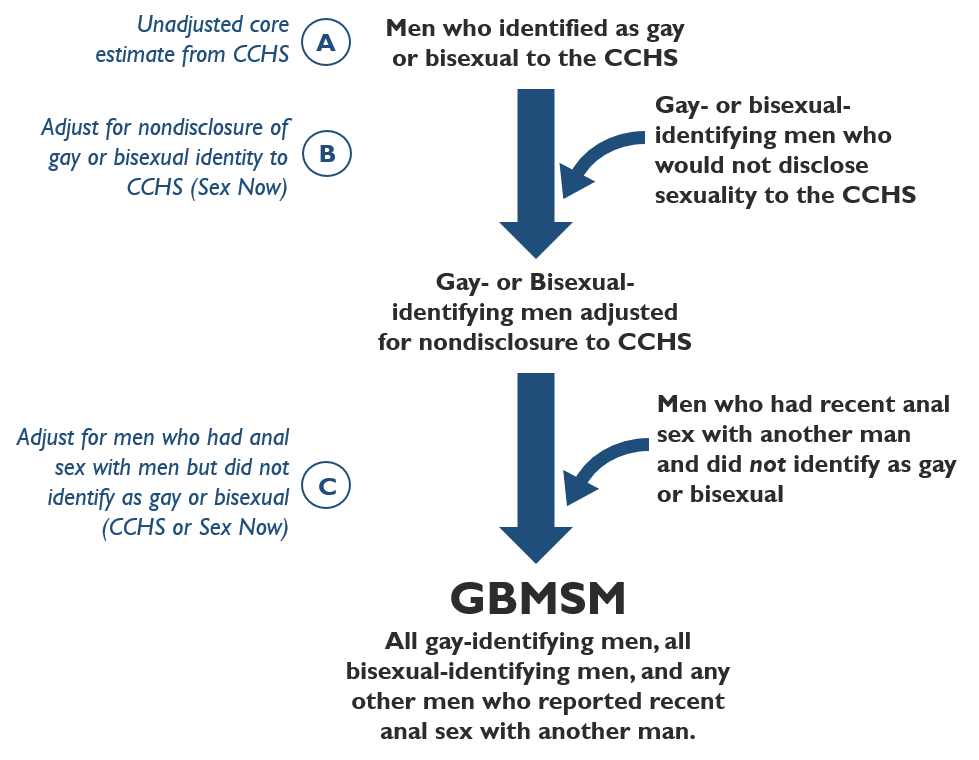
Figure I Summary of adjustment steps taken in modelling the estimate of GBMSM in Ontario. Studies listed in brackets indicate the data source(s) that inform the adjustment. Recent sex with another man is defined as anal sex in the past six (Sex Now) or twelve (CCHS) months. The letters in circles for each step correspond with the subheadings that follow. CCHS = Canadian Community Health Survey.
A. Unadjusted estimated count of men who identified as gay or bisexual from the CCHS
A custom data tabulation from the CCHS provided to us from Statistics Canada used data across 2017 to 2019 and each participant (aged 15 years and older) weighted to account for participation bias in the survey1. In 2017 and 2018, the question used to determine sexual orientation was: “Do you consider yourself to be…?” with the response options “Heterosexual (sexual relations with people of the opposite sex); Homosexual, that is lesbian or gay (sexual relations with people of your own sex); Bisexual (sexual relations with people of both sexes)”. In 2019, the CCHS survey changed the wording to “what is your sexual orientation” with response options “Heterosexual”, “Homosexual”, “Bisexual”, or “Please specify”. Statistics Canada redistributed “please specify” to the first three response options where appropriate. The number of males that responded homosexual or bisexual were tabulated to produce an estimated base unadjusted count of men who identified as gay or bisexual.
B. Adjust for non-disclosure of gay or bisexual identity
The base estimate was first adjusted to account for non-disclosure of gay or bisexual identity to the CCHS. In the 2019 Sex Now survey, the questionnaire asked “Would you reveal your sexual orientation if asked in a Statistics Canada survey?” with the Likert scale response options “Very likely; Likely; Somewhat unlikely; Totally unlikely”. The number of males that responded homosexual or bisexual to the CCHS were considered to constitute the proportion that responded “Very likely” or “Likely” to the Sex Now survey, and the estimates were correspondingly inflated.
C. Adjust for men who had sex with men but did not identify as gay or bisexual
The estimate was lastly adjusted to include men who have sex with men but did not identify as gay or bisexual. Both the CCHS and the 2019 Sex Now surveys provided data to inform this adjustment. Among gay- and bisexual-identifying men and other men who reported recent anal sex with men (defined as >0 male anal sex partners but not gay or bisexual identity), the proportion that identified as gay or bisexual was calculated from both the CCHS and Sex Now surveys. The number of gay- and bisexual-identifying men adjusted for non-disclosure (B above) was deemed to constitute this proportion and the number was correspondingly inflated.
Recent anal sex with another man is defined as anal sex in the past six (Sex Now) or twelve (CCHS) months. Both the CCHS and Sex Now surveys provided data to inform this adjustment point. Each survey was used, creating two different estimates. These two estimates were then averaged to provide a single estimate.
Prevalence of diagnosed HIV among GBMSM in Ontario
Prevalence is defined as the proportion of a population that is affected with a particular disease at a given time. To calculate the prevalence of diagnosed HIV among GBMSM in Ontario, the number of GBMSM living with diagnosed HIV in Ontario in 2018 was divided by the total number of GBMSM estimated above.
The number of GBMSM living with diagnosed HIV in Ontario was estimated by summing the following three estimated numbers (1 + 2 + 3):
- The estimated number of individuals living with diagnosed HIV known to be GBMSM.
- The number of individuals estimated to be GBMSM from the total individuals living with linked diagnosed HIV with unknown priority population (and therefore unknown GBMSM status).
- Estimated by applying the proportion attributed to GBMSM where priority population known to the total individuals where priority population was unknown.
- The number of individuals estimated to be GBMSM from the total individuals living with diagnosed HIV but for whom OHESI only has viral load testing data and no linked nominal diagnostic HIV test.
- These were reasoned to predominantly represent individuals originally diagnosed through anonymous (unlinked) HIV testing; thus, the proportion of anonymous tests that were attributed to GBMSM was applied to these individuals to produce an estimate of how many were GBMSM.
The sum of these three estimates comprised the estimated number of GBMSM living with diagnosed HIV in Ontario in 2018, and was divided by the total number of GBMSM estimated above to produce an estimate of prevalence of diagnosed HIV in this population for 2018. More information about how the number of individuals living in Ontario with diagnosed HIV were estimated can be found in the OHESI report “HIV care cascade in Ontario: Linkage to care, in care, on antiretroviral treatment, and virally suppressed, 2018”.
- See https://www23.statcan.gc.ca/imdb/p2SV.pl?Function=getSurvey&SDDS=3226 for more information on CCHS methods and survey weighting.

